
A ball is released from rest at the left end of three different tracks. The tracks are bent from pieces of metal of the same length.
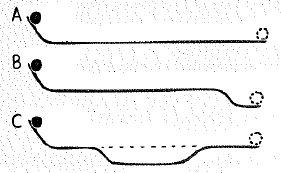
a. From fastest to slowest, rank the tracks in terms of the speed of the ball at the end. Or, do all balls have the same speed there?
b. From longest to shortest, rank the tracks in terms of the time for the ball to reach the end. Or do all balls reach the end in the same time?
c. From greatest to least, rank the tracks in terms of the average speed of the ball. Or do the balls all have the same average-speed on all three tracks?
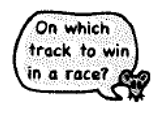
(a)
To rank: The tracks in terms of speed of ball at the end from fastest to slowest.
Answer to Problem 24A
B > C = A
Explanation of Solution
Given:
The three different tracks are shown below.
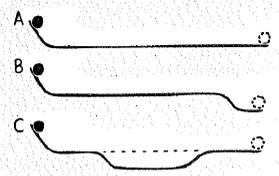
Also, ball is released from rest position.
Formula used:
Assuming there is no friction on the tracks. When the ball is moving on the downfall curve then speed increases due to gravitational force. When it moves its upward curve then speed decreases as the ball has to do work against gravitational force.
Calculation:
On track A, only 1 downward curve is present. So, the ball will gain speed and then moves in constant speed on the straight line.
On track B, there are 2 downward curves present. So, the ball will gain speed with the first one and then after moving for a while in a straight line will again gain speed on the second downfall. Thus, end up with the maximum speed.
On track C, there are 2 downfalls and one upward curve. The ball will first behave as it was on track B and then due to the upward curve, it will work against gravity. Thus, its speed will decrease and ends up with similar speed as the ball has at the end of track A.
Conclusion:
Thus, balls have equal speed on tracks C and A. But, on track B, ball has maximum speed. Hence, ranking will be such as B> C= A.
(b)
To rank: The tracks from longest to shortest in terms of time taken by the ball to reach the end.
Answer to Problem 24A
A> B> C.
Explanation of Solution
Given:
The three different tracks are shown below.
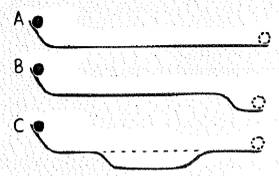
Also, ball is released from rest position.
Formula used:
Time is inversely proportional to speed for a particle for a distance.
Calculation:
Consider track A. The ball in this case will accelerates when it is on the downward curve. After that it travels with a constant speed. Thus, travelling with the constant speed will have the longest time taken of all three.
Consider track B. During each downward curve, the ball will accelerate.This means that it will accelerate twice. So the ball will end up with the higher speed. Falling twice on the downward tracks will have the maximum speed. So, it quickly speeds up and thus lesser time will be taken to reach to the end.
Consider track C. The ball will accelerate twice, but during the upswing segment it will decelerates once. So its velocity on the final segment is same after the dip, as it was before.
C track can be illustrated as shown in the figure below.
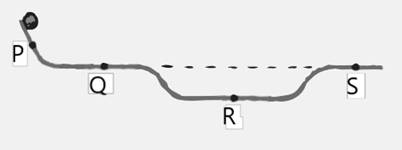
P: slower, but accelerating
Q: faster and constant speed
R:firstly, accelerates and moves with constant speed then decelerates
S: fastest speed equivalent to segment Q
The average speed of the ball will have faster speed as on segment Q. Thus, will take the least amount of time to get to the end.
Conclusion:
Therefore, the rank is A>B> C
(c)
To rank: The tracks in terms of average speed of the ball from greatest to least.
Answer to Problem 24A
Ranks from largest to the least average speed of the ball is as follows C> B> A.
Explanation of Solution
Given:
The three different tracks are shown below.
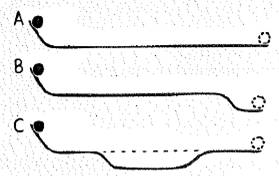
Also, ball is released from rest position.
Formula used:
Average speed is calculated as the total distance travelled on the tracks divided by the time taken.
Calculation:
Time and speed are inversely proportional to each other. So, for longest time average speed will be less in comparison to the shortest time for the same distance.
From part (b), time taken by ball on track C is lowest so the average speed will be highest. While the time taken by ball on track A is highest so the average speed will be lowest
Conclusion:
Therefore, rank of tracks on the basis of average speed is C> B> A.
Chapter 4 Solutions
CONCEPTUAL PHYSICS-W/PRACTICING PHYSICS
Additional Science Textbook Solutions
Campbell Biology (11th Edition)
Chemistry: An Introduction to General, Organic, and Biological Chemistry (13th Edition)
Microbiology with Diseases by Body System (5th Edition)
Chemistry & Chemical Reactivity
Genetic Analysis: An Integrated Approach (3rd Edition)
Applications and Investigations in Earth Science (9th Edition)
- A = 45 kN a = 60° B = 20 kN ẞ = 30° Problem:M1.1 You and your friends are on an archaeological adventure and are trying to disarm an ancient trap to do so you need to pull a log straight out of a hole in a wall. You have 1 rope that you can attach to the log and there are currently 2 other ropes and weights attached to the end of the log. You know the force and direction of the ropes currently attached are arranged as shown below what is the magnitude and direction 'e' of the minimum force you need to apply to the third rope for the force on the log to be in direction of line 'a'? What is the resultant force in direction 'a'? a ////// //////arrow_forwardanswer both questionsarrow_forward- 13- 3. Shastri recalled reading that for an ideal transformer, "the ratio of the primary voltage to the secondary voltage is equal to the ratio of the secondary current to the primary current." Plan and design an experiment to investigate whether the statement above is true. (8) • With the aid of a fully labelled circuit diagram, describe a procedure which can be used to investigate whether the statement is true. The circuit diagram must include the following components: A variable AC voltage supply • AC voltmeters • AC ammeters A transformer with adjustable turns ratio Connecting wires • ° A load resistorarrow_forward
- sunny (1) -13- end. One box contains nothing inside; one has a piece of resistance wire between the terminals You are provided with three sealed identical matchboxes labelled A, B and C, with terminals at each and the other, a semi-conductor diode. Plan and design an experiment to identify the contents of each box. You are provided with the following elements for your apparatus: Ammeter Low voltage power supply Connecting wires Labelled circuit diagram Draw a well-labelled circuit diagram to show how you would connect the apparatus listed above to each matchbox. (3 maarrow_forwardRAD127 Radiographic Equipment and Computers SI Units in Radiography Ch. 1 & 2 Instructions: Provide the units for each of the following in full and short forms 1. Mass - kg, 9 or (1b)) ・ 2. Energy, Work - W = FD,J 3. Air kerma -(Gya) 4. Absorbed Dose- 5. Effective Dose J/kg (94+) jlkg J/kg, Sv 6. Radioactivity - 5-1, Bq 7. Weight 8. Time 9. Force 10. Power B9 wt, wt-mg, N -(s) F= ma, N, OR 1b. (JIS), P= work It = Fdlt, Jarrow_forwardanswer 1-8arrow_forward
- 1 . Solve the equation 2/7=y/3 for y. 2. Solve the equation x/9=2/6 for x. 3. Solve the equation z + 4 = 10 This is algebra and the equation is fraction.arrow_forwardtwo satellites are in circular orbits around the Earth. Satellite A is at an altitude equal to the Earth's radius, while satellite B is at an altitude equal to twice the Earth's radius. What is the ratio of their periods, Tb/Taarrow_forwardFresnel lens: You would like to design a 25 mm diameter blazed Fresnel zone plate with a first-order power of +1.5 diopters. What is the lithography requirement (resolution required) for making this lens that is designed for 550 nm? Express your answer in units of μm to one decimal point. Fresnel lens: What would the power of the first diffracted order of this lens be at wavelength of 400 nm? Express your answer in diopters to one decimal point. Eye: A person with myopic eyes has a far point of 15 cm. What power contact lenses does she need to correct her version to a standard far point at infinity? Give your answer in diopter to one decimal point.arrow_forward
 College PhysicsPhysicsISBN:9781305952300Author:Raymond A. Serway, Chris VuillePublisher:Cengage Learning
College PhysicsPhysicsISBN:9781305952300Author:Raymond A. Serway, Chris VuillePublisher:Cengage Learning University Physics (14th Edition)PhysicsISBN:9780133969290Author:Hugh D. Young, Roger A. FreedmanPublisher:PEARSON
University Physics (14th Edition)PhysicsISBN:9780133969290Author:Hugh D. Young, Roger A. FreedmanPublisher:PEARSON Introduction To Quantum MechanicsPhysicsISBN:9781107189638Author:Griffiths, David J., Schroeter, Darrell F.Publisher:Cambridge University Press
Introduction To Quantum MechanicsPhysicsISBN:9781107189638Author:Griffiths, David J., Schroeter, Darrell F.Publisher:Cambridge University Press Physics for Scientists and EngineersPhysicsISBN:9781337553278Author:Raymond A. Serway, John W. JewettPublisher:Cengage Learning
Physics for Scientists and EngineersPhysicsISBN:9781337553278Author:Raymond A. Serway, John W. JewettPublisher:Cengage Learning Lecture- Tutorials for Introductory AstronomyPhysicsISBN:9780321820464Author:Edward E. Prather, Tim P. Slater, Jeff P. Adams, Gina BrissendenPublisher:Addison-Wesley
Lecture- Tutorials for Introductory AstronomyPhysicsISBN:9780321820464Author:Edward E. Prather, Tim P. Slater, Jeff P. Adams, Gina BrissendenPublisher:Addison-Wesley College Physics: A Strategic Approach (4th Editio...PhysicsISBN:9780134609034Author:Randall D. Knight (Professor Emeritus), Brian Jones, Stuart FieldPublisher:PEARSON
College Physics: A Strategic Approach (4th Editio...PhysicsISBN:9780134609034Author:Randall D. Knight (Professor Emeritus), Brian Jones, Stuart FieldPublisher:PEARSON





